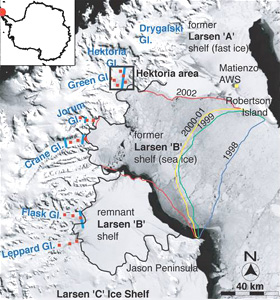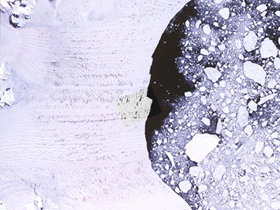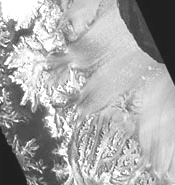 |
 |
 |
 |
 |
 |
 |
 |
 |
 |
|
|
 |

|
Home > Environmental Issues > Article > |
|||||

Antarctic Peninsula glaciers
|
NASA Release 04-302
|
The TerraNature series of articles on global warming present the ice caps at the polar regions as the best indicators of climate change. Melting of the ice caps, which contain 70 percent of the world's fresh water, is the principal potential contributor of rising sea level, but the future rate of melting is unknown. Recent studies of Antarctic ice indicate the impact of one event on another, and show how complex predicting melting escalation is. |
The results also suggest climate warming can rapidly lead to rises in sea level. Large ice shelves in the Antarctic Peninsula disintegrated in 1995 and 2002 as a result of climate warming.
Almost immediately after the 2002 Larsen B ice shelf collapse, researchers found nearby glaciers flowing up to eight times faster than prior to the breakup. The speed-up also caused glacier elevations to drop by as much as 38 meters (124 feet) in 6 months.
"Glaciers in the Antarctic Peninsula accelerated in response to the removal of the Larsen B ice shelf," said Eric Rignot, a JPL researcher and lead author of one of the studies. "These two papers clearly illustrate, the relationship between ice shelf collapses caused by climate warming, and accelerated glacier flow".
"If anyone was waiting to find out whether Antarctica would respond quickly to climate warming, I think the answer is yes," said glaciologist Ted Scambos. In 15 years, 150 miles of coastline has changed drastically.
The papers illustrate relationships between climate change, ice shelf breakup, and increased flow of ice from glaciers into oceans. Increased flow of land ice into oceans contributes to sea level rise. While the Larsen area glaciers are too small to significantly affect sea level, they offer insight into what will happen when climate change spreads to regions farther south, where glaciers are much larger.
|
Five images of the Antarctic Peninsula from before and after the Larsen B breakup revealed crevasses on the surfaces of glaciers. By tracking crevasse movement in sequence from one image to the next, researchers were able to calculate velocities of the glaciers. Image: CSA |
The surfaces of glaciers dropped rapidly as the flow sped up. Thinning of the glaciers was so dramatic it was easily detected with ICESat, which can measure elevation to within an inch or two.
The Scambos study examined the period right after the Larsen B ice shelf collapse to try to isolate the immediate effects of ice shelf loss on the glaciers.
According to Rignot's study, the Hektoria, Green and Evans glaciers flowed eight times faster in 2003 than in 2000. They slowed moderately in late 2003. The Jorum and Crane glaciers accelerated two-fold in early 2003 and three-fold by the end of 2003.
Adjacent glaciers, where the shelves remained intact, showed no significant changes according to both studies. The studies provide clear evidence ice shelves restrain glaciers, and indicate present climate is more closely linked to sea level rise than once thought.


|
 |

 View series of Larsen images
View series of Larsen images View larger image
View larger image